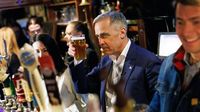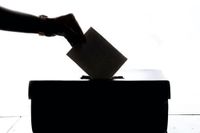As the 2025 federal election campaign heats up, a recent poll from Innovative Research has shown the Conservative Party leading for the first time, with support at 38 percent compared to the Liberal Party's 37 percent. This marks a notable shift in a race that has seen the Liberals consistently ahead since the campaign kicked off on March 23, 2025. Despite this new development, analysts caution that these numbers may not translate into a Conservative majority, as the Liberal Party's continued efficiency in vote distribution could still secure them a minority government.
According to Innovative Research, the Conservatives have managed to narrow the gap in Liberal momentum. "The Liberal campaign is still scoring more points with more people, but their advantage is much smaller," the firm stated. This shift in polling is a significant development in a campaign defined by fluctuating voter sentiments and shifting allegiances.
However, the Conservative lead is not universally reflected across all polling data. Other major pollsters, including Leger, Nanos, and Angus Reid Institute, continue to show the Conservatives trailing by margins of up to nine points. For instance, a Nanos poll released on April 2, 2025, indicated the Liberals at 45.8 percent and the Conservatives at 36.7 percent. Similarly, a Postmedia-Leger poll from the same day had the Liberals at 44 percent, with the Conservatives just slightly behind at 38 percent.
Amid these conflicting results, the Conservatives did receive a glimmer of hope from an Abacus Data poll published on March 30, 2025, which revealed a tie at 39 percent between the two major parties. Yet, given the historical context of the last two elections, where the Conservatives garnered a plurality of the popular vote but secured significantly fewer seats than the Liberals, the implications of these numbers remain complex. The Liberal Party tends to excel in tight ridings, often winning seats with as little as 36 percent of the vote, while Conservative votes in safe ridings can be considered "wasted" in terms of seat allocation.
Regionally, the Innovative Research poll indicated that the Conservatives are leading in British Columbia and are tied with the Liberals in Ontario at 41 percent. This is in stark contrast to the Leger/Postmedia poll, which found the Liberals holding a 10-point lead in both provinces. The polling landscape is further complicated by a resurgence in support for both the New Democratic Party (NDP) and the Bloc Québécois, which could potentially trim the size of any future Liberal caucus.
The 2025 election is already being characterized by wild swings in polling data and significant discrepancies among different polling firms. David Coletto from Abacus Data noted that one of the critical factors influencing voter behavior this time around is turnout. He stated, "It looks like one of the big areas of disagreement among some polls is what non-voters in 2021 are going to do." Abacus is working to segment out 2021 non-voters who plan to participate in the upcoming election, revealing a Conservative lead of 40 percent over the Liberals' 31 percent within this demographic.
In a related electoral battle, Paul Manly, the Green Party candidate for Nanaimo—Ladysmith, has positioned himself as a strong contender against Conservative candidate Tamara Kronis. Manly claims to be the progressive choice, asserting that he has the backing needed to defeat Kronis. However, NDP candidate Lisa Marie Barron has raised skepticism, reminding voters that similar claims were made in the last election when she emerged victorious.
A new poll conducted by Oraclepoll Research for the Green Party between March 29 and 31, 2025, indicates a surge in Liberal support in Nanaimo—Ladysmith, with the party now polling at 27 percent, up from just 6 percent in February. The Conservatives lead with 34 percent, down from 41 percent, while the Greens have slightly increased their support to 29 percent. The NDP has seen a significant drop, now at just 9 percent, down from 22 percent.
Despite the fluctuating numbers, early projections by the polling aggregator 338 Canada suggest that the Conservative candidate is currently leading in the riding, followed closely by the NDP, Liberal, and Green parties. In a February poll, the Green Party asked Liberal and NDP supporters if they would consider voting Green in a two-way race against the Conservatives. A striking 88 percent of NDP voters and 78 percent of Liberal voters expressed willingness to support the Greens in that scenario.
Michael MacKenzie, a political analyst, describes the Nanaimo—Ladysmith riding as one of the most competitive in the country, highlighting the genuine four-way race among the NDP, Conservatives, Greens, and now the resurgent Liberals. He emphasizes the importance of voter turnout, noting that previous elections have shown a significant majority against the Conservatives in this riding, but that dividing the non-Conservative vote could allow the Conservatives to win.
Both the Green Party and the NDP have been vocal advocates for electoral reform, pushing for a shift away from Canada’s first-past-the-post system. The Greens push for proportional representation, while the NDP supports a mixed-member proportional system. Barron has been active in promoting these changes, arguing for a system that better reflects the will of Canadian voters.
As the election approaches on April 28, 2025, the political landscape remains dynamic. The resignation of Prime Minister Justin Trudeau and the economic pressures from the United States have added further complexity to the electoral narrative. With the New Democrats facing declining support, the outcome of the election remains uncertain, hinging on voter turnout and the ability of parties to consolidate their bases.
In conclusion, the 2025 federal election is shaping up to be one of the most unpredictable in Canadian history, with significant implications for the future of the country’s political landscape. The shifting dynamics among the major parties, regional variations in support, and the potential for increased voter participation all contribute to a highly charged electoral atmosphere.






